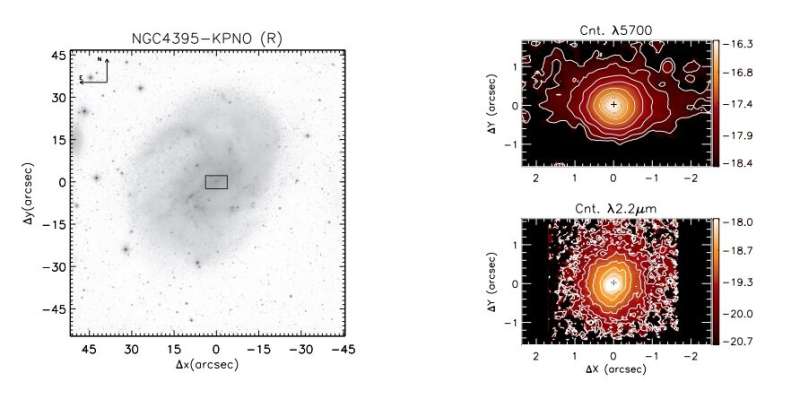Left panel: large-scale image of NGC 4395 at R-band (Cook et al 2014). Right panels: optical (top) and K-band (bottom) continuum images obtained from the GMOS and NIFS data cubes, respectively. Credit: Brum et al., 2019.
An international team of astronomers has conducted optical and spectroscopic observations of the dwarf galaxy NGC 4395 that contains an active galactic nucleus (AGN). The observations, described in a paper published March 19 on arXiv.org, allowed the researchers to take a closer look at this dwarf AGN, what could provide essential insights into the nature of this object.
AGNs are compact regions at the center of galaxies, more luminous than surrounding galaxy light. They are very energetic due either to the presence of a black hole or star formation activity at the core of the galaxy.
AGNs in local dwarf galaxies offer an excellent opportunity to study relatively small supermassive black holes (SMBHs). By conducting detailed analysis of the gas kinematics ionization structure and gas morphology in such dwarfs, astronomers could gather crucial information about evolution of small SMBHs.
Located some 14.3 million light years away, NGC 4395 is an example of a nearby dwarf galaxy known to harbor an AGN. It is perceived as a great candidate to investigate the nature of a dwarf AGN, as its proximity allows telescopes to take a close look at its nucleus.
That is why a group of astronomers led by Carine Brum of Federal University of Santa Maria in Brazil decided to perform optical and near-infrared integral field spectroscopic observations of the inner region of NGC 4395. For this purpose, they employed the Gemini Multi-Object Spectrograph (GMOS) and the Gemini Near-infrared Integral Field Spectrograph (NIFS), both mounted on the Gemini North Telescope in Hawaii.
The observational campaign allowed the researchers to estimate the properties of ionized and molecular gas in NGC 4395. In particular, optical and near-infrared emission-line flux distributions uncovered an elongated structure at about 78 light years west of the nucleus.
"The line emission peaks at the nucleus but is also extended in a blob at 1.'2 (24 pc) west of the nucleus," the astronomers wrote in the paper.
Gas in this blob is blueshifted by approximately 30 km/s compared to the surrounding material. This, according to the researchers, suggests that the gas flowing toward the nucleus at a rate of about 0.00032 solar masses per year. However, the origin of the inflowing material is uncertain. The scientists assume that it may be an ongoing minor merger of a gas-rich small galaxy, or the accretion of a low-metallicity cosmic cloud.
Furthermore, the authors of the paper estimated that the bolometric luminosity of the AGN in NGC 4395 is about 99 duodecillion erg/s, and the mass of the central black hole is approximately 250,000 solar masses. They also calculated that the mass within the radius of about 32.6 light years from the nucleus is around 770,000 solar masses, most likely due to the presence of a young nuclear stellar cluster in this region.
All in all, the results of the study allowed the researchers to find out that NGC 4395 differs from typical Seyfert galaxies due to the lower mass inflow rate and due to the fact that gas inflow in the studied galaxy seems to be undergoing a minor merger or accretion event.
More information: Carine Brum et al. A close look at the dwarf AGN of NGC 4395: optical and near-IR integral field spectroscopy. arXiv:1903.08083 [astro-ph.GA]. arxiv.org/abs/1903.08083
© 2019 Science X Network
























